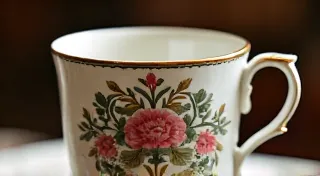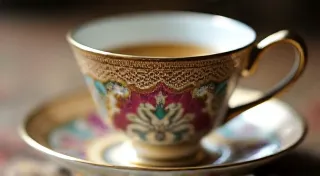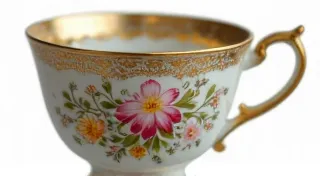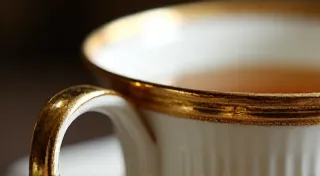Celebrating the Art Deco Tea Cup: Styles and Manufacturers
The Art Deco era, spanning roughly from the 1920s to the 1930s, brought a distinctive aesthetic to all aspects of design – and tea cups were no exception. Characterized by bold geometric shapes, luxurious materials, and a sense of optimism, Art Deco tea cups remain highly sought-after collectibles today. This article delves into the styles and manufacturers that defined this iconic period, offering insights for both seasoned collectors and those just beginning their journey into antique tea cup identification.
Defining Characteristics of Art Deco Tea Cups
Unlike the delicate, often floral designs of the Victorian era, Art Deco teacups embraced modernity. Here's what to look for:
- Geometric Patterns: Expect to see strong vertical lines, zigzags, chevrons, stepped patterns, and stylized sunbursts.
- Bold Colors: While pastels weren’t absent, Art Deco favored richer, more saturated hues like emerald green, sapphire blue, ruby red, and black. Gold accents were incredibly common.
- Streamlined Shapes: Cups and saucers displayed a sense of movement and speed, often featuring a sleek, simplified form.
- Exotic Motifs: Inspired by Egyptian, Mayan, and Asian art, you might see stylized depictions of pyramids, lotus flowers, or peacock feathers.
- Luxury Materials: Fine porcelain was standard, often combined with materials like Bakelite (an early plastic) for handles or decorative elements.
Key Manufacturers of Art Deco Tea Cups
Several prominent manufacturers left their mark on the Art Deco tea cup landscape. Here are a few of the most recognizable:
Shelley
Shelley was a major player in the Art Deco movement, producing a vast array of patterns catering to diverse tastes. Their "Cloverleaf" and "Renaissance" patterns are particularly well-regarded and command high prices in the collector's market. Look for Shelley hallmarks, which can vary depending on the era and manufacturing location.
Royal Doulton
Royal Doulton's Art Deco range is characterized by sophisticated designs, often incorporating floral motifs in a streamlined Art Deco style. Their "Asparagus" and "Larch" patterns are highly collectible. The quality of the porcelain is consistently high. The history of English porcelain manufacturers is rich and varied, and exploring the story of companies like Royal Doulton provides valuable context for appreciating these beautiful pieces.
Minton
Minton produced luxurious Art Deco tea cups for a more exclusive market. Their designs frequently featured intricate gilding and detailed hand-painted elements. Identifying marks can be complex, requiring careful study of Minton’s factory hallmarks.
Wedgwood
Wedgwood's contribution to the Art Deco era is often marked by a focus on clean lines and understated elegance. While not as flamboyant as some other manufacturers, their pieces are known for their impeccable craftsmanship. Examining Wedgwood's legacy alongside other makers often reveals fascinating details about design trends and consumer preferences during the Art Deco period.
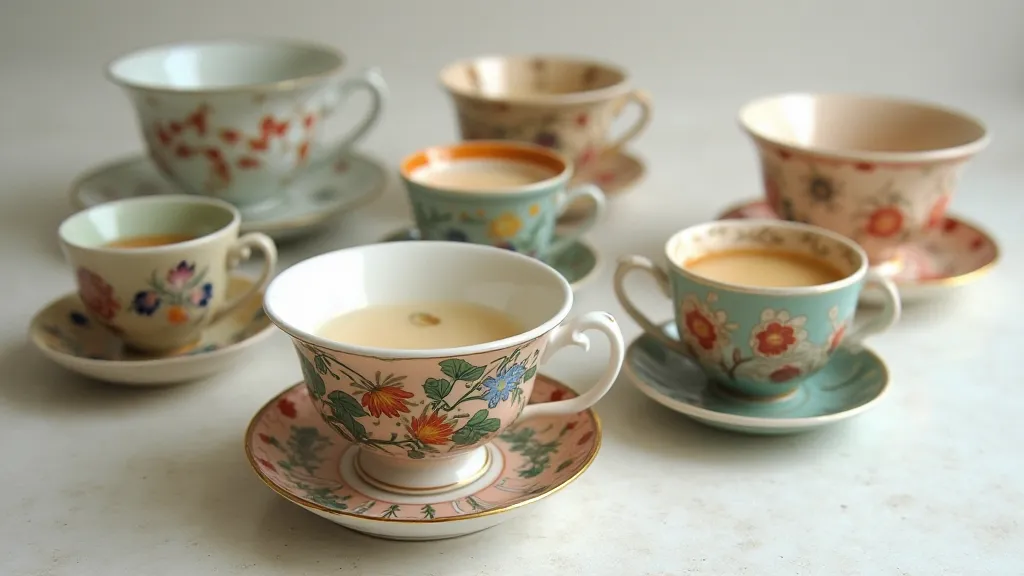
Identifying Marks and Hallmarks
Accurate identification is crucial for dating and valuing antique tea cups. Manufacturers’ marks, often found on the base of the cup and saucer, provide vital clues. However, these marks can change over time, and some pieces may lack any visible markings. Researching specific manufacturer marks online and consulting with experienced collectors is highly recommended. Look for subtle variations in font and design, as these can indicate specific production periods. Understanding the nuances of these marks is essential. For a deeper dive into the history and identification of English porcelain, you might find valuable insights by learning about Worcester tea cups and the distinctive characteristics they possess.
Collecting Tips for Art Deco Tea Cups
- Do Your Research: Familiarize yourself with the hallmarks of key manufacturers.
- Condition is Key: Look for pieces in excellent condition – cracks, chips, and crazing (fine lines) significantly impact value.
- Focus on Patterns: Some patterns are more desirable than others.
- Attend Auctions and Antique Shows: These are excellent venues for finding rare and unique pieces.
Beyond Art Deco: Exploring Related Styles
While Art Deco is a distinct period, it's often helpful to appreciate it within the broader context of ceramic design history. Styles like the elaborate details of Belleek tea cups, with their uniquely Irish charm, offer a beautiful contrast. Similarly, delving into the production history of Belleek tea cups can illuminate the diversity of ceramic artistry throughout the 20th century.
The Irish Connection and Collector's Appreciation
The global appeal of antique tea cups extends far beyond national borders. The appreciation for finely crafted porcelain, like those produced by Irish manufacturers, demonstrates the enduring power of artistic heritage. For collectors interested in a broader view, studying various production methods and artistic influences can significantly enhance their appreciation for the craft.
Maintaining and Caring for Your Art Deco Treasures
Preserving the beauty of your Art Deco tea cups requires careful handling and proper storage. Avoid drastic temperature changes and abrasive cleaning agents. A gentle hand wash with mild soap is always recommended. Regular dusting with a soft cloth will help maintain their luster.
Conclusion
Art Deco tea cups offer a fascinating window into a time of optimism and artistic innovation. With their distinctive styles and rich history, these collectibles continue to captivate collectors and enthusiasts worldwide. By understanding the key characteristics, manufacturers, and identification techniques discussed in this article, you can embark on your own rewarding journey into the world of Art Deco tea cup collecting. And for those keen to expand their knowledge of fine porcelain, exploring the legacy of makers like Coalport—as detailed in The Rise of Coalport: A History and Identification Guide—will offer further enriching perspectives.
